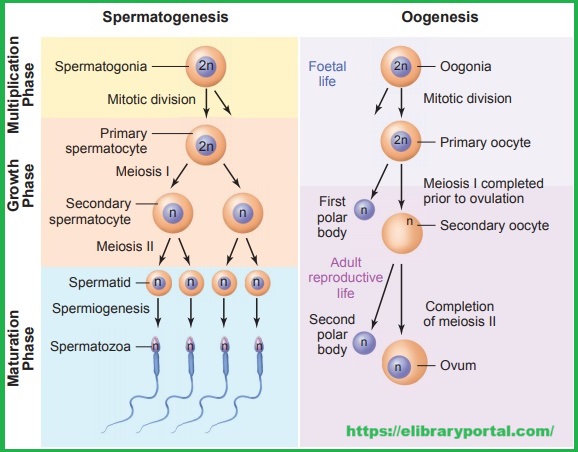
Gametogenesis is the biological process by which male and female sex cells, known as gametes, are formed. This process is crucial for sexual reproduction because it results in the production of sperm in males and eggs (ova) in females. These gametes carry half the genetic information of the parent, and during fertilization, they combine to form a complete set of chromosomes, resulting in the formation of a zygote, which can develop into an embryo.
The two main types of gametogenesis are:
- Spermatogenesis – the process of forming sperm cells in males.
- Oogenesis – the process of forming egg cells in females.
1. Spermatogenesis (Formation of Sperm Cells)
Spermatogenesis occurs in the testes (male reproductive organs). The process involves several stages, starting with a diploid cell (a cell with a full set of chromosomes) and ending with haploid sperm cells (cells with half the chromosomes).
Stages of Spermatogenesis:
- Spermatogonia: These are diploid cells found in the walls of the seminiferous tubules of the testes. Spermatogonia multiply by mitosis to produce more cells. Some of these cells undergo differentiation to become primary spermatocytes.
- Primary Spermatocytes: These are diploid cells that undergo meiosis I (a type of cell division that reduces the chromosome number by half). After meiosis I, each primary spermatocyte gives rise to two haploid secondary spermatocytes.
- Secondary Spermatocytes: These cells undergo meiosis II, a process similar to mitosis. Each secondary spermatocyte divides to form two spermatids, which are immature sperm cells.
- Spermatids: These are immature haploid cells that undergo spermiogenesis, a process of maturation where they develop into mature, functional spermatozoa (sperm cells).
- Spermatozoa: Mature sperm have three parts:
- Head – Contains the nucleus with the genetic material (DNA) and is covered by an enzyme-filled structure called the acrosome, which helps the sperm penetrate the egg during fertilization.
- Midpiece – Contains mitochondria, which provide energy for the sperm’s movement.
- Tail (flagellum) – Provides mobility, allowing the sperm to swim towards the egg.
In total, spermatogenesis takes around 64 days in humans, and the process is continuous from puberty onward. Each cycle of spermatogenesis produces millions of sperm cells, ensuring that males have a constant supply of sperm available for reproduction.
2. Oogenesis (Formation of Egg Cells)
Oogenesis is the process by which egg cells (ova) are formed in females. This process occurs in the ovaries and begins before a female is born. Unlike spermatogenesis, which occurs continuously, oogenesis has distinct stages that span a female’s lifetime.
Stages of Oogenesis:
- Oogonia: These are diploid cells that are produced in large numbers during fetal development. By the time a female is born, most of the oogonia have transformed into primary oocytes, which are arrested (paused) in the first phase of meiosis (meiosis I).
- Primary Oocytes: At birth, a female’s ovaries contain thousands of primary oocytes. These cells remain arrested in prophase I of meiosis until puberty. After puberty, during each menstrual cycle, one primary oocyte resumes meiosis and continues the process of maturation.
- Secondary Oocyte: When meiosis I is completed during each menstrual cycle, a secondary oocyte is produced along with a polar body (a small cell that contains half the chromosomes but very little cytoplasm and eventually degenerates). The secondary oocyte begins meiosis II but stops at metaphase II. It will only complete meiosis II if fertilization occurs.
- Mature Ovum (Egg): If a sperm cell fertilizes the secondary oocyte, meiosis II is completed, and a mature ovum is formed. A second polar body is also produced during this process and eventually degenerates. The mature ovum is a large, nutrient-rich cell that provides the necessary environment for the developing zygote.
In contrast to spermatogenesis, oogenesis produces only one functional ovum from each primary oocyte, along with polar bodies that are discarded. The process is not continuous; it occurs cyclically, with one egg being released approximately every 28 days during the menstrual cycle.
Key Differences Between Spermatogenesis and Oogenesis
| Feature | Spermatogenesis | Oogenesis |
|---|---|---|
| Location | Testes | Ovaries |
| When it begins | At puberty | Before birth |
| Duration | Continuous after puberty | Cyclical after puberty |
| Number of gametes produced | Millions of sperm daily | One egg per menstrual cycle |
| Polar bodies | None | Polar bodies are formed |
| Function of gametes | Sperm fertilizes the egg | Egg provides nutrients for embryo |
3. Importance of Gametogenesis
Gametogenesis is crucial for sexual reproduction because it ensures that each parent contributes half of the genetic material required to form a new individual. The combination of the sperm and egg during fertilization restores the diploid chromosome number in the zygote, which will divide and develop into an embryo.
This process also introduces genetic diversity through meiosis, which involves:
- Crossing over: Exchange of genetic material between homologous chromosomes during meiosis I, which results in new combinations of genes.
- Independent assortment: Random distribution of chromosomes to gametes during meiosis, ensuring that each gamete carries a unique set of genetic information.
These mechanisms increase variation in offspring, which is essential for the evolution and adaptability of species.
4. Disorders Associated with Gametogenesis
Sometimes, errors can occur during gametogenesis, leading to disorders. Some common examples include:
- Aneuploidy: This is the presence of an abnormal number of chromosomes in a cell. For example, Down syndrome occurs when there is an extra copy of chromosome 21.
- Infertility: Problems with gamete production, such as low sperm count in males or failure to ovulate in females, can lead to difficulties in conceiving.
See in Fig:

Questions & Answers on Gametogenesis: The Process of Formation of Gametes:
1. What is Gametogenesis?
Answer:
Gametogenesis is the process of formation and development of gametes (sperm in males and eggs in females) through meiotic cell division. This process occurs in the gonads (testes in males and ovaries in females) and is crucial for sexual reproduction as it ensures the generation of haploid gametes, which fuse during fertilization to form a diploid zygote.
2. What is Spermatogenesis, and where does it occur?
Answer:
Spermatogenesis is the process of sperm cell development, which occurs in the seminiferous tubules of the testes. It involves several stages, beginning with the spermatogonia (diploid cells), which undergo mitosis and then meiosis to eventually form haploid spermatozoa (sperm cells). The process is supported by Sertoli cells, which nourish the developing sperm.
3. What is Oogenesis, and how does it differ from Spermatogenesis?
Answer:
Oogenesis is the process of egg cell (ovum) formation in females, occurring in the ovaries. It differs from spermatogenesis in that it results in the formation of one mature egg and three polar bodies from a single oogonium. Oogenesis begins during fetal development and is paused at prophase I of meiosis until puberty, when it resumes during each menstrual cycle. Unlike continuous spermatogenesis, oogenesis has long pauses and produces fewer gametes.
4. Explain the role of Meiosis in Gametogenesis.
Answer:
Meiosis is a type of cell division that reduces the chromosome number by half, producing haploid gametes from diploid germ cells. In males, meiosis occurs during spermatogenesis, where primary spermatocytes divide to form haploid spermatids. In females, meiosis happens during oogenesis, where primary oocytes give rise to a mature ovum and polar bodies. Meiosis ensures genetic diversity through recombination and independent assortment of chromosomes.
5. What are the different stages of Spermatogenesis?
Answer:
Spermatogenesis involves three main stages:
- Multiplication phase: Spermatogonia (stem cells) divide by mitosis.
- Growth phase: Spermatogonia differentiate into primary spermatocytes.
- Maturation phase: Primary spermatocytes undergo meiosis I to form secondary spermatocytes, which then undergo meiosis II to form spermatids. Spermatids mature into spermatozoa in a process called spermiogenesis.
6. Describe the stages of Oogenesis.
Answer:
Oogenesis occurs in three stages:
- Multiplication phase: Oogonia (stem cells) divide by mitosis during fetal development.
- Growth phase: Oogonia grow and differentiate into primary oocytes, which are arrested in prophase I of meiosis until puberty.
- Maturation phase: At puberty, primary oocytes resume meiosis, forming a secondary oocyte and a polar body. The secondary oocyte is arrested in metaphase II and is only completed if fertilization occurs, leading to the formation of the ovum and another polar body.
7. What are Polar Bodies, and what is their significance in Oogenesis?
Answer:
Polar bodies are small, non-functional cells produced during oogenesis as a result of asymmetric division of the cytoplasm. They contain the same amount of genetic material as the ovum but very little cytoplasm. Their formation ensures that the egg retains most of the cytoplasm and nutrients required for early embryonic development. Polar bodies typically degenerate and have no further role in reproduction.
8. How do Sertoli cells assist in Spermatogenesis?
Answer:
Sertoli cells, also known as “nurse cells,” are found in the seminiferous tubules of the testes. They provide structural and nutritional support to developing sperm cells. Sertoli cells create a blood-testis barrier that protects germ cells from harmful substances. They also secrete signaling molecules that regulate the progression of spermatogenesis and facilitate the release of mature spermatozoa into the lumen of the seminiferous tubules.
9. What hormonal regulation governs Gametogenesis?
Answer:
Gametogenesis is regulated by hormones from the hypothalamus, pituitary gland, and gonads. The hypothalamus secretes gonadotropin-releasing hormone (GnRH), which stimulates the anterior pituitary to release follicle-stimulating hormone (FSH) and luteinizing hormone (LH). In males, FSH stimulates Sertoli cells to support spermatogenesis, while LH stimulates Leydig cells to produce testosterone. In females, FSH stimulates the growth of ovarian follicles, and LH triggers ovulation and the formation of the corpus luteum.
10. How does the process of fertilization relate to Gametogenesis?
Answer:
Fertilization is the union of male (sperm) and female (egg) gametes, both of which are produced by gametogenesis. During fertilization, the haploid sperm and egg combine to form a diploid zygote, restoring the chromosome number and initiating embryonic development. Successful gametogenesis ensures the formation of healthy, viable gametes that can participate in fertilization and lead to the generation of offspring.






